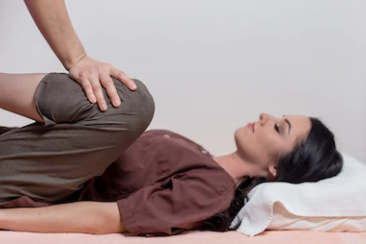Thai massage is unlike any other type of massage you’ve experienced. For one, you do not lie idly about while the masseuse pummels or manipulates your muscles. In Thai massage, your body is an active participant in the massage. Although, like other types of massage, you come away feeling relaxed and refreshed.
History of Thai Yoga Massage
While the name may suggest that Thai massage’s history begins in Thailand, its origins date 2500 years ago in India. It also has its basis in yoga. Northern Indian doctor, Jivaka Kumar Bhaccha, is credited with developing Thai yoga massage. His massage technique is believed to have traveled to Thailand in about the 3rd or 2nd-century B.C.E.
Like yoga and other Eastern philosophies, such as Traditional Chinese Medicine (TCM) and Ayurveda medicine, Thai massage is built on the concepts of subtle energy. In yogic philosophy, subtle energy is called prana, and in TCM it is called qi (pronounced chi). Prana is our life force and is affected by other energies around us, such as air and food. Prana flows along channels called prana nadis, which is like the idea of meridian channels in acupuncture.
Thai yoga massage works on ten of these energy pathways to release blocked prana that contributes to illness, pain, and tension in the body. This is another way that Thai massage is different from most Western massage methods. Swedish and other similar massage techniques work on the physical body and not subtle energy. Western massage sees tight muscles as a physical problem whereas Thai massage views tight muscles as a weak flow of energy which results in the physical symptoms of shortened muscles, inflexibility, pain, etc.
What Does Thai Massage Look Like?
As mentioned earlier, the Thai massage masseuse will not knead or stretch muscles and other tissue. Instead, she will move your arms and legs into various “positions.” One of the reasons its referred to as Thai yoga massage is because of the positioning and stretching of limbs.
For example, with the client on her stomach, the masseuse may kneel on the buttocks or between the legs and stretch the client arms behind her. In yoga, this pose is called cobra. Or the client kneels with the therapist behind her. Using her feet, the therapist will press her feet into the client’s back while stretching the arms. In other words, the therapist will use her hands, arms, legs, and feet to pull the body or apply pressure as needed.
The ambiance of the Thai massage therapy room is the same as other massage rooms: It’s very relaxing with soft lighting and music. However, instead of a table, Thai yoga massage is typically done on a comfortable, cloth-covered padded mat on the floor.
Another difference from Western massage is that the client remains fully clothed. Loose fitting clothes are necessary because of the movement of the extremities. Thai massage therapy masseuse may also apply pressure to acupressure points and use compression. The therapist will not, however, use oils.
Like other types of massage therapist, Thai massage therapist are trained and need to be licensed in most states. With your first appointment, the masseuse will have an intake form for you to fill out listing your health condition, medications, and other pertinent information.
Before performing the massage, the therapist will review your intake form with you and discuss what she will be doing. Also, as with all types of massage, the client is in control of the intensity of the stretch, pressure, etc.
Health Benefits of Thai Yoga Massage
Thai massage has many of the same benefits as other massages, such as reducing stress and encouraging relaxation. There are other health benefits from receiving a Thai massage:
Headaches – Research published in Evidence-Based Complementary and Alternative Medicine showed Thai massage was helpful for people with persistent headaches.
Chronic Pain, A study in 2015 published in Complementary Therapies in Clinical Practice, showed that Thai massage offered temporary relief from chronic pain. Some participants reported 15 to 80 percent pain relief that lasted up to 15 weeks.
Scapulocostal Syndrome – Scapulocostal syndrome is a painful condition that begins in the neck and moves to the shoulders and arms with the most painful area being beneath the scapula. Thai massage studies showed a reduction in pain and muscle tension. The relief from Thai massage was better than from physical therapy.
As with all therapies, Thai Yoga massage may not be suitable for everyone. Always seek the advice of your medical caregiver before engaging in any treatment, especially if you are pregnant or have a health condition.
Thai yoga massage is done differently than typical massage methods, but it offers some of the same benefits, such as stress reduction. It can, however, provide additional benefits like improving flexibility and range of motion because of its relationship to yoga, which may be the best of both worlds.
References:
- Aarons, Jonathan M.D. Scapulocostal Syndrome (January 4, 2015). Retrieved from http://www.paindoctorfortlauderdale.com/scapulocostal-syndrome/.
- Cespedes, Andrea. Benefits of Thai Yoga Massage (January 30, 2018). Retrieved from https://www.livestrong.com/article/135880-benefits-thai-yoga-massage/.

